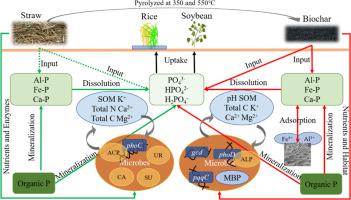Science of the Total Environment ( IF 9.8 ) Pub Date : 2021-09-14 , DOI: 10.1016/j.scitotenv.2021.150325 Caidi Yang 1 , Shenggao Lu 1

|
Crop straw is commonly returned back to agricultural fields to improve soil nutrient status. In order to compare the effects of straw returning modes (direct and carbonization returning) on the phosphorus (P) availability in acidic soils and explore possible chemical and microbial mechanisms, a pot experiment was conducted. The rice straw, canola stalk at the rate of 1% (w/w) and their corresponding biochar produced by the same amount of straw at 350 °C and 550 °C were used, and two-season crops (rice and soybean) were planted. Results indicated that the content of available P in biochar-treated soils was significantly higher than in the straw-treated soils owing to the biochar soluble P and increased pH. Straw returning increased the activities of urease, sucrase and catalase more than biochar. Biochar mode significantly increased the activity of alkaline phosphatase (ALP), while decreased the acid phosphatase (ACP) relative to the straw mode. Likewise, there were a significant rise in the copy number of phoD gene and a drop of phoC in the biochar mode. The P functional genes (phoD, gcd and pqqC) had the higher copy numbers in soils with biochar made at 350 °C. Similarly, biochar made at 350 °C improved the yields of rice and soybean more effectively. Therefore, straw returning modes affected the availability of P differently via chemical and microbial pathways and the ALP regulated by phoD played a crucial role in the conversion of P. Results demonstrated that biochar returning had a larger impact on the availability of P and developed the effectiveness of crop production than the straw returning directly.
中文翻译:

秸秆和秸秆生物炭对 Ultisol 中磷的有效性、酶活性和微生物功能基因的影响不同
农作物秸秆通常返回农田以改善土壤养分状况。为了比较秸秆还田方式(直接还田和炭化还田)对酸性土壤磷(P)有效性的影响,探索可能的化学和微生物机制,进行盆栽试验。稻草、油菜秆按1%(w/w) 及其相应的由等量秸秆在 350°C 和 550°C 下生产的生物炭,并种植两季作物(水稻和大豆)。结果表明,由于生物炭可溶性磷和pH值升高,生物炭处理土壤中有效磷的含量显着高于秸秆处理土壤。秸秆还田对脲酶、蔗糖酶和过氧化氢酶活性的提高幅度大于生物炭。与秸秆模式相比,生物炭模式显着提高了碱性磷酸酶 (ALP) 的活性,同时降低了酸性磷酸酶 (ACP) 的活性。同样,在biochar模式下,phoD基因的拷贝数显着增加,phoC下降。P 功能基因(phoD、 gcd 和pqqC) 在 350 °C 制备的生物炭的土壤中具有更高的拷贝数。同样,在 350 °C 下制成的生物炭更有效地提高了水稻和大豆的产量。因此,秸秆还田方式通过化学和微生物途径对磷的有效性产生不同的影响,phoD调控的 ALP 在磷的转化中起着至关重要的作用。农作物产量高于秸秆直接还田。


























 京公网安备 11010802027423号
京公网安备 11010802027423号